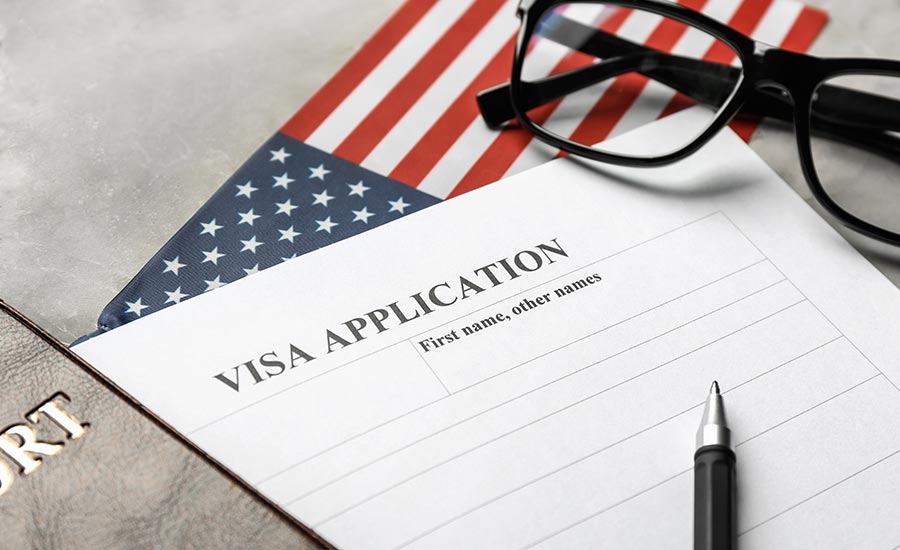

If you’re engaged to a United States citizen and you live outside of the country or married to a partner who legally resides in the U.S., understanding your options to join your loved one in the U.S. is crucial for navigating the immigration process.
We’ll break down the differences between a fiancé visa vs. spouse visa in terms of requirements, process, and cost.
We’ll also explain how our experienced immigration attorneys at Spar & Bernstein can become your trusted ally in uniting you with your loved one in the U.S.
What Is A Fiancé Visa?
As a nonimmigrant visa, the fiancé or K-1 visa enables the foreign fiancé of a U.S. citizen to enter the U.S. and marry their partner no later than 90 days after the fiancé’s arrival into the country.
Once the couple is married in the U.S., the foreign spouse must go through an adjustment of status to become a Green Card holder.
The K-1 visa is non-renewable and expires once the 90-day-period is over.
If the engagement ends before the couple is married, the U.S. sponsor can withdraw the fiancé visa petition and the foreign fiancé must leave the U.S.
If the relationship ends after the couple is married, the foreign spouse may still qualify for an immigration option.
Holders of K-1 visas are allowed to work only after applying for a work permit (employment authorization).
U.S. permanent residents are not eligible to file a petition for a K-1 visa.

What Is A Spouse Visa?
As an immigrant visa, the spouse or marriage-based visa enables the foreign spouse of a U.S. citizen or lawful permanent resident to enter the U.S. and establish permanent residency (Green Card status).
The foreign spouse can enter the U.S. through:
- A conditional resident visa (CR-1), if the couple has been married for less than two years at the time the visa application is granted/approved. Upon arrival to the U.S., CR-1 visa holders receive a conditional Green Card with a validity of two years.
- An immediate relative visa (IR-1), if the couple has been married for two or more years at the time the visa application is granted/approved. Upon arrival to the U.S., IR-1 visa holders receive a Green Card with a validity of 10 years.
Spouse visa holders are allowed to start work immediately after their arrival to the U.S.
If the Green Card is conditional, the couple must apply for removal of conditions by filing Form I-751, Petition to Remove Conditions of Residence, 90 days before their conditional Green Card expires.
If the marriage ends in divorce and the foreign spouse has a permanent Green Card, their immigration status is typically not threatened.
However, if the foreign spouse has a conditional Green Card and wants to remain in the U.S., they must petition for a permanent Green Card individually.
Partnering with an experienced immigration lawyer is highly recommended to avoid the risk of deportation after the conditional card expires.

Fiancé Visa vs. Spouse Visa: Requirements
While the K-1 visa and spouse visa both aim to reunite couples in the U.S., each has its own unique requirements.
Fiancé Visa Requirements
Application requirements for a K-1 visa include:
- The U.S. sponsor must be a U.S. citizen
- • The U.S. sponsor must be able to financially support the foreign fiancé, with an income over 100% of the most recent Federal Poverty Guidelines
- The foreign fiancé must live outside the U.S.
- The foreign fiancé must have a clean criminal record
- The foreign fiancé must meet the set health requirements
- • Both the U.S. sponsor and the foreign fiancé must be free to marry, with any previous marriages being officially terminated
- • The couple must provide proof of a legitimate relationship
- • The couple must have met at least once during the two years before the visa application is submitted
Spouse Visa Requirements
Application requirements for a spouse visa include:
- The U.S. sponsor must be a U.S. citizen or a lawful permanent resident
- The U.S. sponsor must prove that they can support their foreign spouse financially, with an income over 125% of the most recent Federal Poverty Guidelines
- The couple must have a legal, bona fide marriage
- The marriage must have been entered into outside of the U.S.
- The foreign spouse must be eligible for a U.S. immigrant visa
Fiancé Visa vs. Spouse Visa: Application Process
Although the two share some similar steps, the application process differs for a K-1 visa vs. a marriage-based visa.
To apply for a K-1 visa:
- The U.S. citizen files Form I-129F, Petition for Alien Fiancé, with U.S. Citizenship and Immigration Services (USCIS)
- The applicant, also known as beneficiary, files Form DS-160, Nonimmigrant Visa Application, after being notified by the Embassy or Consulate in their country that the National Visa Center (NVC) conducted a preliminary visa processing
- The beneficiary attends an interview at the Embassy or Consulate in their home country
- If the application is approved, the beneficiary receives their fiancé visa
- The beneficiary travels to the U.S. and is admitted into the country at a port of entry
- The couple marries within 90 days after the fiancé’s arrival
- The beneficiary files Form I-485, Application to Register Permanent Residence or Adjust Status
To apply for a spouse visa:
- The U.S. sponsor (citizen or lawful permanent resident) files Form I-130, Petition for Alien Relative, with USCIS
- Once the foreign spouse is notified that the NVC completed the preliminary processing, they file Form DS-160, Immigrant Visa Application, along with Form I-864, Affidavit of Support Under Section 213A of the INA, along with the required supporting documents
- The foreign spouse visits the Embassy or Consulate for a visa interview
- If the application is approved, the foreign spouse obtains their spouse visa
- The foreign spouse enters the U.S.
- The foreign spouse receives their Green Card
If you’re not sure which type of visa you’re looking for or how to go about the application process, our team at Spar & Bernstein can help. Call us to schedule a consultation with our experienced immigration attorneys.
Fiancé Visa vs. Spouse Visa: Cost
The cost of a K-1 visa, including the adjustment of status, is currently $2,380, which includes:
- $675 for filing Form I-129F, Petition for Alien Fiancé
- $265 for filing Form DS-160, Nonimmigrant Visa Application
- $1,440 for filing Form I-485, along with the biometrics fee
Optional costs include a work permit at $260 and a travel permit at $630.
The cost of a spouse visa is currently $1,340, which includes:
- $675 for filing Form I-130, Petition for Alien Relative on paper (or $625 for online filing)
- $120 for reviewing Affidavit of Support documents
- $325 for filing Form DS-160, Immigrant Visa Application
- $220 for the USCIS immigrant fee, including the Green Card production
To stay updated with the latest information on cost, process and requirements, contact our immigration team at The Law Offices of Spar & Bernstein.
Our knowledgeable and compassionate attorneys will review your case details, provide the information you need and help you pursue your dream of joining your loved one in the U.S. or bringing your loved one to the U.S.
Fiancé Visa vs. Spouse Visa: Processing Time
The processing times for a K-1 visa petition by USCIS range between eight and 24 months.
The time USCIS needs to process a spouse visa petition is:
- Between 14 and 38 months for the spouse of a U.S. citizen
- Between 19 and 60 months for the spouse of a U.S. permanent resident
The time it takes to process a petition varies by field office or service center, while the estimated time is calculated based on the time it took to process 80% of the same type of petition over the past six months.
To check the estimated time of the field service or service center where your petition was filed, visit the Processing Time page on the USCIS website.
How Spar & Bernstein Can Help You With Your Fiancé Or Spouse Visa
As a trusted immigration law firm, our experienced attorneys at Spar & Bernstein represent clients in all aspects of immigration law, including family immigration, citizenship and naturalization and nonimmigrant visas.
Our caring and compassionate team is well aware of the complexities involved in obtaining a fiancé or spouse visa and they work with every client to ensure guidance and support throughout the process.
Whether you are looking to join your fiancé or spouse in the U.S. or you’re looking to act as your fiancé’s sponsor, we will help you gather and file the documentation needed, assist with any additional requirements such as interviews and background checks and address any concerns you might have about the process.
If challenges arise, our knowledgeable lawyers will handle all legal complexities and advocate on your behalf to fight for the approval of your fiancé or spouse visa.
Contact our team to become one of the thousands of our clients whose success stories we have proudly played a role in helping them achieve.
Pursue a family life together in the U.S. with your partner by working with the experienced team of Spar & Bernstein!
Fiancé Visa vs. Spouse Visa: FAQs
For more insights into fiancé visa vs. spouse visa, check out our section with frequently asked questions.
Which type of visa is faster to obtain, a fiancé visa or a spouse visa?
Typically, a fiancé visa takes less time to process compared to a spouse visa. However, after entry into the U.S. and marriage, the process to obtain a Green Card is generally quicker for spouses entering on a CR-1 or IR-1 visa.
Can my fiancé(e) or spouse apply for U.S. citizenship?
Yes, both K-1 visa holders and spouses who obtain Green Cards can apply for U.S. citizenship after meeting residency and other requirements.
Can I apply for a K-1 visa if I am already legally married to a U.S. citizen?
No, if you are already legally married to a U.S. citizen and want to enter the U.S, you cannot apply for a K-1 visa. Instead, you should apply for a spouse visa (CR-1 or IR-1 visa).
Can I apply for a K-1 visa if we have not met in person yet?
No, meeting in person at least once within the two years preceding the filing of the petition is one of the requirements for the K-1 visa. There are limited exceptions to this requirement, such as when travel is prohibited by culture, religion, or local custom, would cause significant physical hardship, or if the foreign national has a medical condition preventing travel.
Can I enter the United States on a different visa while waiting for the K-1 visa approval?
Technically, yes, but it is generally not recommended to enter the U.S. on a different visa with the intention of marrying and adjusting status. Doing so could lead to complications and potential accusations of visa fraud.
Can I apply for a Green Card if I have come to the U.S. on a spouse visa and we have been married for less than two years at the time of entry?
Yes, if you have been married for less than two years and have entered the U.S. on a CR-1 visa, you will receive conditional residency. Together with your spouse, you must jointly apply to remove conditions within two years of receiving the Green Card.


